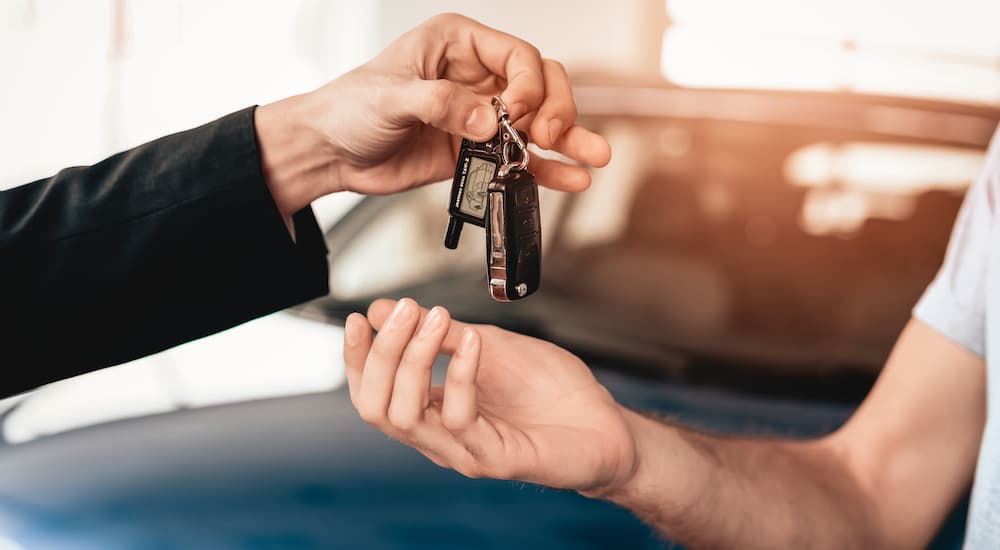Trading in your vehicle can be a very challenging process if you don’t know what you’re doing and how to go about valuing your vehicle to get the most money from your trade. Don’t worry, though. We specialize in helping you make the right decisions when it comes to buying, trading, selling, and shopping for a new or used vehicle. It’s our specialty to help you make the tough decisions when it comes to shopping smartly within the auto market, from how to value your trade to how to prep your vehicle so you can get a better trade value.
There’s a lot you need to know when trading in a vehicle, like the terms you need to be aware of, the right words to use to get the right kind of information, and the phrases you need to understand when shopping the market for the best valuation of your vehicle. We have put together a must-have source of information covering all the basics of trading in a vehicle, including what to bring, what to do, and the checklists you need to make before you settle in on trading in your current vehicle.
Valuing Your Trade: Learning the Lingo
There are some important terms and consistently used phrases or words that may frequently appear when you attempt to trade in or sell your vehicle. Many of these terms will be used throughout the auto market landscape when selling your car, whether it be privately, through an auction, or at a dealership. Learning these terms can help you better navigate the landscape when it comes to valuing your trade and getting the most out of trading your vehicle in.
Bill Of Sale: This relates to the terms and conditions of selling your vehicle. Most dealerships don’t require a bill of sale, but most private sales do. It outlines the vehicle, warranty, delivery information, price, and signatures. Basically, all of the documented procedures and details associated with the sale of the vehicle between two parties.
Truth In Mileage: This refers to the Truth In Mileage Act. If you are making a private sale, you will need to disclose the official odometer readings in writing. It goes hand-in-hand with the bill of sale.
Equity: The difference between what’s owed/paid for in the vehicle compared to its worth. You can have positive equity (the car is worth more than what you paid) or negative equity (the car is worth less than what you paid).
Financing: When you get a loan through a financial institution like a bank to help you pay for your vehicle.
Lien: If you get financing from a bank, the bank may have a lien on the vehicle you’re financing, meaning that they own the title of the vehicle until you pay off the loan.
Loan: This is the actual finances you’ve received for the purchase. The loan is whatever was taken out through the financial institution to pay for the vehicle. This is money you will pay back in installments over time.
OEM: This stands for Original Equipment Manufacturer. You may need to have OEM parts replaced or installed on a vehicle, meaning original parts from the automaker. Some vehicles you trade your car in for may also have OEM reconditioning done, which means they had to have original parts from the manufacturer installed or replaced.
ROI: This stands for Return on Investment. Basically, it’s what you’re getting back from the vehicle based on what you put into it.
Title: This is the official name of the ownership papers for the vehicle. If you paid off your vehicle, then you own the title. If you still have a loan on the car, then the lienholder will hold the title.
Trade: When you bring your vehicle to a dealership and use the value of that vehicle towards the purchase of a new one, you are making a trade. Rather than selling the vehicle outright, getting cash, and then buying something new, you are taking the value of your current ride and subtracting that value from your next one.
Warranty: A warranty is coverage provided for your vehicle in the event something goes wrong with it due to manufacturing defects. Manufacturers offer warranties on new vehicles and may also offer extra ones on Certified Pre-Owned models. Some dealerships may also offer warranties separate from the manufacturer.

Pre-Trade Checklists: Here’s What You Need to Consider
There are a few things you are going to want to do before you trade in your vehicle in order to get the most money possible for it. First, you are going to want to have an idea of what the vehicle is worth. Do some research into how much your vehicle in its current condition and configuration is worth on the market right now. This will give you a good idea of what your budget ceiling will be after the trade. There are multiple ways to get your vehicle appraised, and sticking with just one method may shortchange you in terms of what you could get for your vehicle. Utilize multiple appraisal tools so you can judge what the best route for trading your vehicle is.
Once you have an idea of what your vehicle will be worth when you’re ready to trade it in, you are going to want to prep it. Doing a little bit of simple prep work on your vehicle can help you get a better final offer when you bring it into the dealership to trade.
What You Need to Do Before Trading in Your Vehicle
One of the most important things to do before you value your trade is to clean your vehicle. You really need to make sure you clean both the inside and outside. Any trash, leftovers, personal items, or belongings that don’t need to be in the vehicle should be cleaned out. This includes pockets, compartments, storage spaces, ashtrays, and everything else in between.
Give the car a good wash-down and waxing as well. Make sure that the vehicle looks as good as possible, as it will actually help increase the potential valuation during appraisal. The newer the vehicle looks, the higher the trade-in value. Ultimately you want to take advantage of that and make sure that you are getting the most for your trade.
This is an optional step, but you might want to get the vehicle inspected for any issues before you bring it in. Address small things like burnt-out lights or low fluid levels, but you can leave anything major for the dealership to take care of. While this may not get your vehicle top dollar (unless the inspection shows you have no issues, which you can show to the appraiser in the hopes of getting a higher offer), it can help you determine the current condition of your vehicle and what its value is most likely to be.
What You Need to Bring for the Trade
Now that you have all of that out of the way, it’s now time to actually make the trade. Bring your vehicle to your dealer of choice for their appraiser to inspect. You’ll want to make sure you have any equipment that originally came with the car, like all the keys and fobs, owner’s manuals, and other extras. You’ll need to show your driver’s license, registration, and title. If the vehicle is still under a loan, bring the buyout amount and loan information.
Do Your Part to Make Trading-In Easy
Ultimately, you want to take as many steps as possible to remove any potential setbacks that might cost or devalue your trade. Do your research, make sure your vehicle is clean inside and out, and have all of the necessary paperwork with you to make the trade process as smooth and efficient as possible. Then you can be in and out of the dealership in no time with your old vehicle traded in for something fresh and new.




